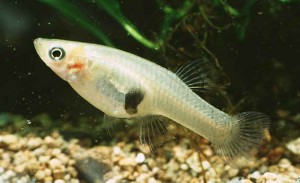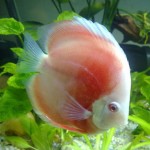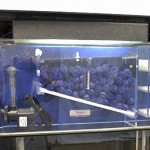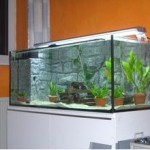
The Mosquito Fish (Gambusia Affinis), is a Livebearer, which means that it gives birth to live free swimming young, rather then laying eggs like most fish. These fish look a lot like the common female guppy, except for the absence of any colour, and this applies to the males too. They also grow to the same size as guppies. These fish have been given the common name of Mosquito Fish, due to their large appetite, for mosquito larvae, that they feast upon. In fact, these fish have been introduced into lakes, rivers and streams for that very purpose.
Usage
These guys really aren’t an ornamental fish, strictly due to their lack of coloration, making them a very dull fish to look at. In fact, if you go to a local fish store, you can pick up about 10 or 20 of them for $2-$3. The main usage of these fish, due to the cheap price, and poor coloration, would be food for larger fish, mainly predatory Cichlids, like Oscars, or Jack Dempsey’s, although on occasions children buy these guys to keep in the community tank.
Tank set up
Large tanks are not needed, and they can get a little aggressive, so don’t keep them with delicate finned fish, like Siamese Fighters, as their fins will get ripped, and possibly infected. Filtration, isn’t overly important, as they’re livebearers, so the young will get sucked up in the filter, so a corner box filter is adequate. If you have a filter like an Aquaclear, or Emperor, cover the intake tubes with nylon stockings so the young don’t get sucked up. pH isn’t important, but keep it around 7, but they can tolerate up to about 7.8, try to avoid extremes. A heavily planted tank, will give the fish room to hide, play, and interact and the fry places to hide. Java Moss is always recommended for livebearer young to hide in, also floating plants also give fry places to hide. A basic community setup would be a 10-12 gallon 2ft tank or larger, air driven corner box, or sponge filter, large clumps of java moss, and about 10 or so fish. Temperature isn’t important, either as these fish tolerate coldwater conditions, even in winter, but keep the water warm if you wish to breed, as this will stimulate them to breed more.
Behavior
These fish, socially interact, by chasing each other around the tank, and a male (usually the largest) sets up his dominance, and will chase other males away from females. They may also setup different schools, as I’ve observed before, I had 3 different schools in the one tank.
Breeding
For those who have bred guppies before, it’s the same setup. Males have a reproductive organ called a gonopdium, that they use to fertilize females, it’s an extension on their pelvic fin. Different methods:
Breeding Trio – 1 male and 2 females, either in a tank by themselves or in a community tank with the same ratio Heavily Planted tank.
Breeding Trap – Pregnant females are put into a breeding trap, when pregnant so fry are dropped trough the trap and can’t be eaten by hungry mothers.
Feeding
Tropical Fish flakes are good, and so are Specialist Guppy Flakes, but for an EXTRA treat, mosquito larvae are great, as these are what they eat naturally in the wild, when they’re not eating there own young. The larvae provide all the nutrients that a mosquito fish needs, and adds some really nice excitement and action to the tank. Brine shrimp are also good, but can get expensive, so mosquito larvae are the best, as they cost nothing to culture.















